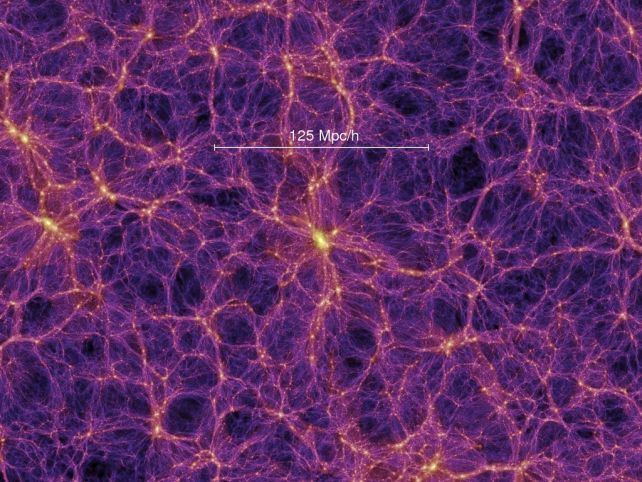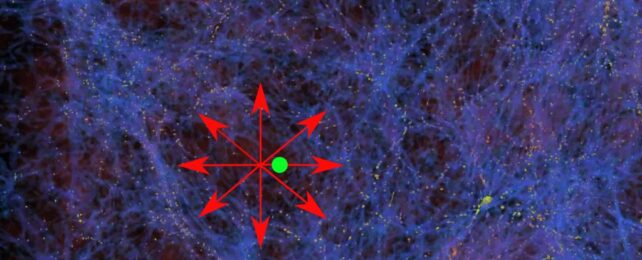When we gaze out into the cosmos beyond the borders of the Milky Way, we behold multitudes. Space is teeming with galaxies, speckled across the darkness like stars. If we stopped there, it would be easy to assume that the distribution of galaxies is more or less even throughout space-time.
But there's some method to the madness: rather than wheeling freely about, galaxies tend to concentrate into clusters and clumps and filaments of the cosmic web, attracted by mutual gravity into matter highways, superhighways and nodes.
The inverse of that is voids – regions of significantly lower density, with relatively few galaxies.
A growing body of evidence suggests that the Milky Way galaxy is drifting on the edge of one of these voids in its little corner of the Universe, a bubble of space known rather obviously as the Local Void.

Previous measurements have put the size of the void at around 60 megaparsecs in size – around 200 million light-years. But that's only part of the picture.
The Local Void may be engulfed by a far larger underdensity, some 600 megaparsecs across, known as the Local Hole, or Keenan-Barger-Cowie (KBC) supervoid.
This supervoid is a big problem, because according to the standard model of cosmology, matter is more or less evenly distributed throughout the Universe.
This standard model can't account for such an enormous underdensity.
But now a new study led by astrophysicist Sergij Mazurenko of the University of Bonn has found that, just maybe, the Local Hole could solve a problem: that of the Hubble Tension, an inability to resolve different measurements of the speed at which the Universe is expanding.
We just need to find a way to work around the standard model.
The rate at which the Universe is expanding is known as the Hubble Constant, or H0. We don't know exactly what that rate is, because different ways of measuring it return different results.

One way is to look at relics of the early Universe, like the Big Bang's leftover light in the cosmic microwave background, or acoustic waves frozen in time. This gives us a rate of about 67 kilometers (42 miles) per second per megaparsec.
Another way is to measure the distances to more recent, closer objects with known brightness, such as Type Ia supernovae, or Cepheid variable stars. This gives a rate of around 73 kilometers per second per megaparsec.
"The Universe, therefore, appears to be expanding faster in our vicinity – that is, up to a distance of around three billion light years – than in its entirety," says astrophysicist Pavel Kroupa of the University of Bonn. "And that shouldn't really be the case."
The problem, the researchers found, can be resolved by taking the Local Hole into account.
Matter attracts matter, gravitationally. Galaxies moving away from us in local space may be locally accelerated by the concentrations of matter around the edges of the supervoid.
It's an idea not dissimilar to a 2020 paper that suggested the Local Void has the same effect, but on a much larger scale.
The problem that remains is that pesky standard model. But this becomes less of a problem if we use a different model for how gravity works.
It's called Modified Newtonian Dynamics (MOND), and it was proposed four decades ago as an alternative explanation to the dark matter theory devised to resolve discrepancies in our measurements of gravity in the Universe.

"The standard model is based on a theory of the nature of gravity put forward by Albert Einstein," says Kroupa.
"However, the gravitational forces may behave differently than Einstein expected."
Under MOND, the Local Hole is a lot easier to resolve. There are, to be clear, significant problems with MOND, too. But it's worth using it as a tool to try to figure out where the holes lie in our current understanding of the Universe.
It may be that the real answer lies somewhere close to a mix of both theories; that Einstein doesn't need to be thrown out, but expanded upon.
"Einstein is thought to have said that we cannot solve problems with the same thinking that led to the problems in the first place," writes physicist Indranil Banik of St Andrews University in an article for The Conversation.
"Even if the required changes are not drastic, we could well be witnessing the first reliable evidence for more than a century that we need to change our theory of gravity."
The research has been published in the Monthly Notices of the Royal Astronomical Society.
